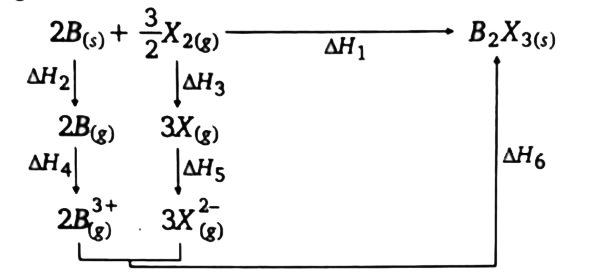Consider the following process for the conversion of A to D.

How many of the following represent the CORRECT expressions, according to the Hess's law?
i. ΔH1+ΔH2+ΔH3=ΔH4+ΔH5
(ii) ΔH6=ΔH4+ΔH5
(iii) ΔH3=ΔH6−ΔH1−ΔH2
(iv) ΔH2=ΔH6−ΔH4−ΔH5
v. ΔH(6)=ΔH1+ΔH2+ΔH3
(vi) ΔH4=ΔH6+ΔH5
The correct Answer is:4
We know that according to the Hess.s law
ΔHnet=∑ΔHr
Since along A to D ΔH6 is the enthalpy change it can be writen as
ΔH6=ΔH1+ΔH2+ΔH3 and
ΔH6=ΔH4+ΔH5
and the above two expressions are equal to each other.
Thus the expressions i,ii,iii and v correctly represent the Hess.s law.
Topper's Solved these Questions
Similar Questions
How many of the following energies are involved in the transformation of Na(s)→Na⊕(aq) ?
(a) 1E , (b) ΔsubHɵ , ( c) ΔdissHɵ, (d ) ΔhydHɵ
(e) ΔuHɵ
View SolutionHow many of the following energies are involved in the transformation of Na(s)→Na⊕(aq) ?
(a) 1E , (b) ΔsubHɵ , ( c) ΔdissHɵ, (d ) ΔhydHɵ
(e) ΔuHɵ
View Solution
Knowledge Check
The equation ΔH=ΔH1+ΔH2ΔH3
AKirchoff s equationBvant't Hoff isothermCvan 't Hoff isochoreDHess's lawNH3(g)+3Cl2→NCl3(g)+3HCl(g),ΔH1
N2(g)+3H2(g)→2NH3(g),ΔH2
H2(g)+Cl2(g)→2HCl(g),ΔH3
The heat of formation of NCl3(g) in the terms of
ΔH1,ΔH2,ΔH3 is :AΔHf=−ΔH1+ΔH22−32ΔH3BΔHf=ΔH1+ΔH22−32ΔH3CΔHf=ΔH1−ΔH22−32ΔH3Dnone of theseWhich of the following defines ΔH∘f ?
ACO(g)+1O2(g)→CO2(g)B12H2(g)+12F2(g)→HF(g)CN2(g)+2H2(g)→2NH3(g)DCdiamond+O2(g)→CO2(g)
How many of the following energies are involved in the transformation of Na(s)→Na⊕(aq) ?
(a) 1E , (b) ΔsubHɵ , ( c) ΔdissHɵ, (d ) ΔhydHɵ
(e) ΔuHɵ
View SolutionWhich of the following defines ΔH∘f ?
View SolutionDerive relationship between ΔH and ΔU.Give example when
(i) ΔH<ΔU
(ii)ΔH=ΔU
(iii)ΔH>ΔU
View SolutionConsider the following Born-Haber's cycle:

(Where ΔH1,ΔH2,ΔH3,ΔH4,ΔH5andΔH6 are in kJ/mol)
Then according to given information the correct statement is/are:
View SolutionGiven,
NH3(g)+3Cl2(g)NCl3(g)+3HCl,−ΔH1
N2(g)+Cl2(g)→2NH3(g),−ΔH2
H2(g)+Cl2(g)→2HClg,−ΔH3
The heat of formation of NCl3(g) in the terms of ΔH1,ΔH2 and ΔH3 is
View Solution
